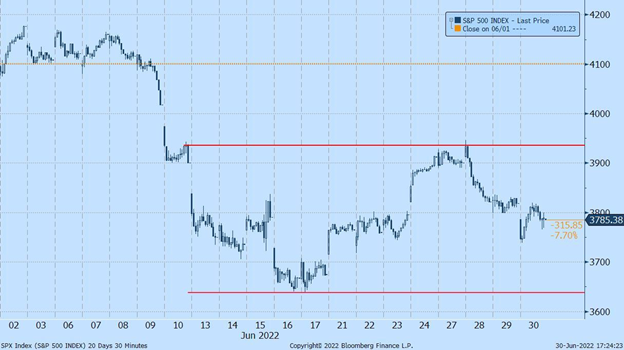By Avi Deustch
June 30, 2022 – As the second quarter of 2022 draws to a close, the state of the U.S. economy is, in a word, perplexing. Real concerns around inflation and the Fed’s policy are buffered by low unemployment and a vibrant summer travel season. In the absence of new hard economic data, these past weeks were marked by tense anticipation as investors sought clues as to what comes next while pouring over the Fed’s dire-sounding announcements. Unsurprisingly, economic outlooks are tainted in political hues accentuated by global and domestic events.
How far and how fast the Fed will have to raise rates is the question of the hour, though of course, even the Fed doesn’t know the answers to these questions. Market sentiments over the Fed’s next moves varied widely throughout the month of June, as can been seen in the two-year treasury rate, an indicator of future short term rates.

There’s no doubt at this point that the Fed was too slow to raise interest rates, believing, as many did, that much of the inflation was transitory. Despite this, the Fed’s slow action should not obscure the compounding challenges posed by the Ukraine war and the continued Covid lockdowns in China. The Fed has virtually no tools to address the supply-side constraints posed by high fuel prices and snarled supply chains. Over-tightening of interest rates that leads to a recession will not change that.
But the Fed is also trying to avoid sustained high inflation, regardless of the cause. If workers and employers expect persistent inflation, they will demand correspondingly higher wages and prices, leading to even more inflation. Even though the Fed can do little do prevent supply-shock inflation, it needs people to believe it can do just that in order to break the cycle.
In light of this, Jerome Powell’s recent announcements about the Fed accepting the risk of a recession to quash inflation are mostly theatrical; a grandstanding designed to convince people that inflation is not here to stay. To be sure, the Fed would absolutely go forward with massive interest rate hikes if needed, but by stating their willingness to ‘do whatever it takes’, Jerome Powell is hoping to use perception to create reality.
As the Fed and everyone else searches for clues as to what comes next, the paucity of new economic data in the last few weeks means that seemingly innocuous data, such as consumer confidence readings, were enough to send the markets careening. While consensus increasingly suggests that peak inflation is behind us, many of us mistakingly thought this several times in the recent past. It’s going to take a few more months until we know where prices are headed and if the Fed needs to execute on all its projected rate hikes.
In the meantime, markets seem to have settled into a holding pattern. The S&P 500 has hovered around 3,800 since mid June, with the current price-to-earnings ratio of 19x inferring only a mild recession. Over this same period oil prices dropped from $120 to $105 per barrel and even Bitcoin seems have settled down, albeit in the $20,000 range.

The data set to be released over the next few weeks will be the real indication as to where the economy is headed. Investors will be especially interested in the latest inflation data set to be released on July 13th, followed by the Fed’s Federal Open Market Committee meeting and the estimated Q2 GDP released in the week of July 25th. Corporate earnings season, which kicks off in mid-July, also promises to be informative if not highly revealing.
As we wait on this data, we expect to see continued volatility in the markets within range-bound trajectory. Major news events, economic or otherwise, could cause a breakout in either direction. On the bright side, a growing number of assets are beginning to trade at attractive prices, especially in the fixed-income markets. While there is no certainty that markets have hit the bottom, long term investors should be on the lookout for opportunities as the they emerge.
Wishing everyone a safe and happy Independence Day!
— AD
